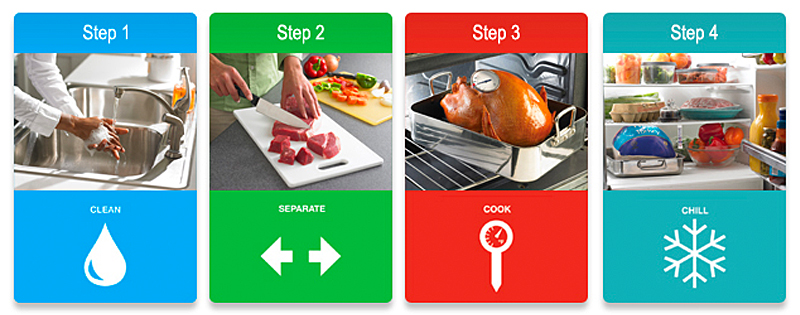
You’ve heard how important it is to wash your hands and to handle food safely, but do you know why it’s important?
And do you know what other steps to take for food safety?
Every day, you handle, cook, and prepare food for you and your family.
The steps you take can mean the difference between a good day and bad case of foodborne illness, also known as “food poisoning.”
(Meet a young woman pregnant with twins, who developed a severe case of food poisoning after eating a food contaminated with Listeria. Her illness threatened her and her twins’ lives. Courtesy of the FDA and YouTube. Posted on May 16, 2018.)
Take a few seconds to learn about food safety whether you’re cooking at home, dining out, or eating ready-made meals on the go.
September is National Food Safety Education Month and a great time to learn the basics.
Handling food safely is important for you and your family.

No matter your age, food safety helps keep food at its freshest and most nutritious, reduces food waste, and prevents food poisoning.
To help keep your food safe, use FDA’s new Food Safety in Your Kitchen materials to plan your next meal!
You’ll find delicious recipes (with steps for food safety already built in), fact sheets, and tips on safe meal prep, storage, and shopping.
(Meet 9 year-old a Rylee. child who developed a severe, nearly fatal case of food poisoning after eating a food contaminated with E. coli., that attacked several of her vital organs and brings her close to death. Courtesy of the FDA and YouTube. Posted on May 16, 2018.)
If you’re under 30, check out FDA’s new Everyday Food Safety materials to learn the essentials of food safety.
You’ll find a helpful video and tip sheets on each of the four steps below.
Step 1: Clean
-
Rinse fruits or vegetables off under cold water.
-
Don’t forget to rinse off produce that has a skin before you cut it.
-
If there are disease-causing germs (bacteria, viruses) on the skin and you cut it with a knife, the knife can carry the germs into the produce.
(See this short clip on preventing foodborne illnesses using shopping tips. Courtesy of the FDA and YouTube. Posted on May 15, 2018.)
Step 2: Separate
-
Step 2 actually starts in your shopping cart!
-
Bag your produce and raw meat, seafood, and poultry in separate plastic bags to keep their juices away from other groceries while you’re shopping.
-
Keep them separate when you get home to prevent cross-contamination.
(Learn More in this short clip on preventing foodborne illness using clean and separate tips. Courtesy of the FDA and YouTube. Posted on May 15, 2018.)
Step 3: Cook
-
Check the temperature! Make sure food is cooked to a safe internal temperature before you eat it. Not sure what the correct temperature is? Here’s a quick reminder:
-
Poultry should be cooked to 165° F.
-
Ground meat, meat mixtures, and egg dishes should be cooked to 160° F.
-
Beef, pork, ham, should be cooked to 145° F and allowed to rest for three minutes.
-
Fish and seafood should be cooked to 145° F.
-
(Another short clip on preventing foodborne illness using serving and storage tips. Courtesy of the FDA and YouTube. Posted on May 15, 2018.)
Step 4: Chill
-
Refrigerate or freeze meat, poultry, eggs, seafood, and other perishables within 2 hours of purchasing or cooking (or 1 hour if the temperature is over 90° F).
-
Never thaw food on your countertop!
-
For defrosting, stick to using the fridge, cold water, or the microwave.
(Finally, this is a short clip on preventing foodborne illness using chill/refrigeration tips. Courtesy of the FDA and YouTube. Posted on May 15, 2018.)
If you’re looking for more information on food safety, please visit FDA’s Education Resource Library to download or order materials.
LEARN MORE..
(Meet Diana, an older adult with a Salmonella infection who, because of the natural weakening of the immune system that comes with age, became dangerously ill. Courtesy of the FDA and YouTube. Posted on May 15, 2018.)















